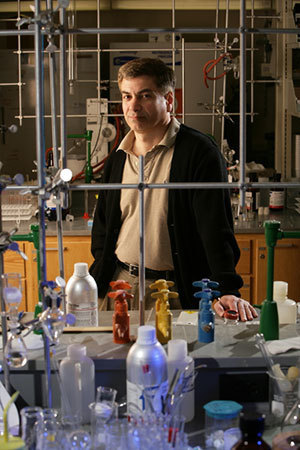 Shahriar Mobashery
Shahriar Mobashery
New research from a team led by Shahriar Mobashery, Navari Family Chair in Life Sciences at the University of Notre Dame, offers an insight into cell wall recycling and virulence of Pseudomonas aeruginosa, an important human pathogen. The research provides a road map for how the post-genomic analyses of biochemical processes will take place to elucidate important metabolic processes.
Pseudomonas aeruginosa is the cause of the bacterial infections that are hard to treat clinically and is the infectious agent that ultimately kills cystic fibrosis patients by colonizing their lungs. This organism has developed an elaborate process that links recycling of its cell wall both to antibiotic resistance and to virulence. Mobashery and his team studied the functions of three homologous enzymes, AmpD, AmpDh2 and Amp3, that are present in the organism. The genomic analysis had revealed the existence of the three, but their roles were not known.
The researchers’ biochemical analyses revealed that the enzyme AmpD is involved in the recycling processes, yet AmpDh2 and AmpHh3 degrade the cell wall in a manner that implicates them in virulence by the organism. Virulence is the basis for how an organism is a difficult pathogen.
Mobashery points out that the first genomes of bacteria were completed in the mid-1990s, yet scientists are still clueless on the functions of many of the genes from the bacterial genome. He stresses that the available genetic information needs to be followed by biochemical studies, like that done by his team on the P. aeruginosa system in elucidation of the functions of complex systems in bacteria.
The research appeared in a series of three papers published in the Journal of the American Chemical Society (J. Am. Chem. Soc. 2013, 135, 4950-4953; J. Am. Chem. Soc. 2013, 135, 10318-10321; J. Am. Chem. Soc., 2013, 135, 12605-12607).